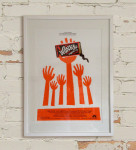Sections: Information | Trailer | Plot Description | Reviews | Articles | Criticism and Analysis | Fun Stuff | Video Covers | DVD Covers | Blu-ray Covers | Soundtrack Album Covers
Information
- Produced in 1971
- What Dahl Did: wrote original children’s book Charlie and the Chocolate Factory and adapted it for the screen
- All Movie Information
- Recent news:
- Playing the “Charlie and the Chocolate Factory” Board Game - February 22, 2020
- Willy Wonka: Former child star pops up on Jeopardy! in the US - April 21, 2018
- Lego Roald Dahl Characters in UK - September 10, 2017
- Storybook Cosmetics collaboration with Dahl - September 3, 2017
- Honest Trailers – Willy Wonka & The Chocolate Factory - August 31, 2017
- Collected in:
- Based on:
Trailer
Plot Description
The world is astounded when Willy Wonka, for years a recluse in his factory, announces that five lucky people will be given a tour of the factory, shown all the secrets of his amazing candy, and will win a lifetime supply of Wonka chocolate. Nobody wants the prize more than young Charlie, but as his family is so poor that buying even one bar of chocolate is a treat, buying enough bars to find one of the five golden tickets is unlikely in the extreme. But in movieland, magic can happen. Charlie, along with four somewhat odious other children, get the chance of a lifetime and a tour of the factory. Along the way, mild disasters befall each of the odious children, but can Charlie beat the odds and grab the brass ring?
Reviews
- RogerEbert.com
- Rotten Tomatoes
- Onion A.V. Club
- CinemaBlend
- Albuquerque Alibi Review
- Vandergrift’s Videos Review
- “Sugar-coated morality tale” by Douglas Macdonald from the January 14, 1972 issue of The Canberra Times – Canberra, Australia (read online)
Articles
- “The Chocolate Revolution” – Roald Dahl gives a lesson on the history of chocolate and the inventions that changed the world
Criticism and Analysis
- “Charlie and the Political-Correctness Factory”
- Essay submitted by Cassandra Pierce
- “Charlie’s Evolving Moral Universe: Filmic Interpretations of Roald Dahl’s Charlie and the Chocolate Factory“
- Essay by June Pulliam published in Fantasy Fiction into Film: Essays
- “Deconstructing Willy Wonka’s Chocolate Factory: Race, Labor, and the Changing Depictions of the Oompa-Loompas” (PDF) – essay by Chryl Corbin published in The Berkeley McNair Research Journal
- “Willy Wonka and the Chocolate Factory as Judeo-Christian Allegory” – an essay submitted by Jeremy Connor
- “Willy Wonka and the Racism Factory” – essay by Jonathan McIntosh published by Boston Indymedia
Fun Stuff
- Movie Images
- Movie Sound Clips
- Movie Song Lyrics
- Why Did the Date Change? – Please help us out!
- Extra Information: Provided by a self-proclaimed “long-time member of the cult of Mr. Willy Wonka”
- Wonka Kids Reunion 1998
- “Willy Wonka Explained [The Veruca Salt Sessions]” (performance at 2004 Melbourne International Comedy Festival and 2010 Edinburgh Fringe Festival)
- “The Fairies” by William Allingham (quoted by “The Tinker”)
Merchandise
- Limited Edition Wonka Print
- Willy Wonka figurine
- Oompa-Loompa Funko Figurine
- Willy Wonka Funko Figurine
- Grandpa Joe Funko Figurine
- Charlie Funko Figurine
- Augustus Gloop Funko Figurine
- Veruca Salt Funko Figurine
- Mike Teevee Funko Figurine
- Set of 5 Wonka Funko Figurines
- Set of 2 Wonka Funko Figurines
- Set of 2 Wonka Funko Dorbz Figurines
- Oompa-Loompa Funko Dorbz Figurine
- Wonka Funko Dorbz Figurine
- Violet Beauregarde Funko figurine
- Funko Playmobil Wonka Set of Two
- Set of 7 Wonka Funko Figurines
- Funko Playmobil Willy Wonka
- Funko Playmobil Oompa-Loompa
- Golden Ticket woven throw
- Golden Ticket pillow
- Golden Ticket fleece blanket
- Whipple Scrumptious Fudgemallow Delight pillow
- Chilly Chocolate Creme pillow
- Nutty Crunch Surprise pillow
- Triple Dazzle Caramel pillow
- Willy Wonka Christmas ornament
- Oompa-Loompa Costume
- Oompa-Loompa Costume
- Oompa-Loompa Costume
- Oompa-Loompa Wig
- Oompa-Loompa Costume
- Oompa-Loompa Costume
- Oompa-Loompa Costume
- Oompa-Loompa Costume
- Willy Wonka Costume
- Willy Wonka Costume
- Willy Wonka 100pc Pocket Puzzle
- Willy Wonka 1000pc Puzzle
- Chocolate Works Unicorn Wonka Bar
- Chocolate Works Hokey Pokey Wonka Bar
- Chocolate Works Candy Cane Wonka Bar
- Chocolate Works Pumpkin Spice Wonka Bar
- Chocolate Works Mini M&Ms Wonka Bar
- Chocolate Works Dark Wonka Bar
- Chocolate Works 1kg Mega Wonka Bar
- Chocolate Works Cookies and Cream Wonka Bar
- Chocolate Works Caramel Wonka Bar
- Chocolate Works White Wonka Bar
- Chocolate Works Milk Wonka Bar
Movie Books
- Pure Imagination: The Making of Willy Wonka and the Chocolate Factory by Mel Stuart
- I Want It Now!: A Memoir of Life on the Set of Willy Wonka and the Chocolate Factory by Julie Dawn Cole
Movie Tie-In Materials
- Tie-In Button
- Tie-In Button
- Tie-In Soundtrack Sheet Music
- Tie-In Wonka Bar
- Elsewhere on the web:
- ‘Willy Wonka and the Chocolate Factory’ Kids Reunite for 44th Anniversary
- Pawn Stars: Original 1971 “Willy Wonka” Props (Season 14)
- 25 Fun Facts About Willy Wonka and the Chocolate Factory
- 22 Things You Never Noticed About Willy Wonka and the Chocolate Factory
- Paris “Mike Teevee” Themmen’s Website
- Wonka Trivia
- Ratings: The Kids from “Willy Wonka”
- Willy Wonka Porter (home–brewed beer)
- Willy Wonka Candy Company
- “The Sequel To Willy Wonka and the Chocolate Factory That Charlie’s Mother Deserves”
- Letters of Note: Part of This World, Part of Another







































































